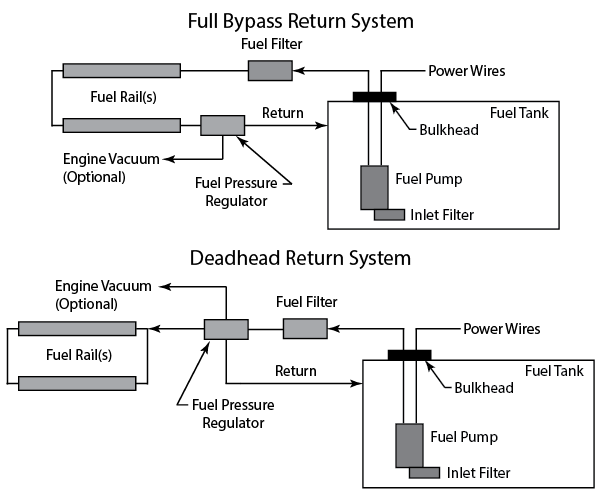When carburetors were the primary means of metering fuel to the engine, the fuel delivery system was easy to understand:
It consisted of a tank, a fuel line pickup in the tank with a filter sock over the inlet, a fuel line to the front of the car, an engine driven mechanical pump, another fuel line to the carburetor, and another filter.
Since carburetors have bowls that hold fuel, and engine vacuum provided the means of moving the fuel from the bowl to the carburetor venturi, the engine could continue running even if there was no fuel available at the pickup in the tank. Fuel sloshing away from the pickup in the tank was not a short-term problem.
The carburetor fuel bowls acts as a mini surge tank. Once fuel became available at the in-tank pickup, the carburetor bowls were re-filled, assuming the engine was still running. Most carburetors require approximately 6psi of fuel pressure to operate properly.
Modern Electronic Fuel Injection (EFI) is a more complicated system, but the basics are still the same:
The fuel must be transported from the tank to the fuel rail(s) on the engine intake manifold.
However, most TBI, Port Injection, and Direct Injection lift pump EFI systems require approximately 3-5bar (42-75psi) to operate properly. The fuel injectors need this high pressure to make a good spray pattern and to deliver the necessary amount of fuel to the engine.
Unlike the carbureted engine that uses vacuum to draw fuel from the fuel bowl, EFI requires that high-pressure fuel be available at all times. If at any time the fuel pressure falls too low the engine will run lean am may stop running. Therefore, a reliable means of delivering high-pressure fuel is needed to keep the engine running under all driving conditions, even when the fuel level is low and sloshing occurs.
The basic components needed in a modern EFI fuel system are:
- Fuel tank
- Fuel pump inlet filter
- High-pressure fuel pump
- Power wires to the fuel pump
- Fuel tubing and hoses to the engine compartment
- Fine element fuel filter
- Fuel pressure regulator
In Diagram 1, the basic components are laid out similar to what they would be in a typical port injection EFI hot rod with the fuel pump mounted in the tank:

Diagram 1. Full bypass and deadhead type return fuel systems.
The full bypass system routes fuel through the engine fuel rail first before reaching the regulator.
In this arrangement the regulator is usually mounted in the engine compartment.
If the regulator was mounted in the rear of the car, then the fuel line and the fuel return line would both be pressurized.
Keeping the number of high-pressure lines to a minimum is a good safety measure. Fuel is also constantly flowing through the fuel rails. With fuel constantly flowing through the rails engine and engine compartment heat is absorbed and returned to the tank. The fuel tank is becoming a thermal battery and being charged with excess heat from the engine compartment.
For the deadhead return system, the fuel pressure regulator is usually mounted either in the engine compartment or near the fuel tank. In this arrangement, fuel does not continuously flow through the engine fuel rails.
For both of these systems, a return is needed to send the excess fuel back to the tank.
Depending on where the regulator is mounted, the return could be:
- A line as long as the primary fuel line.
- Very short line if mounted near the tank.
- Directly returned in the tank.
Many fuel modules have built in fuel pressure regulators, hence making them a single line to fuel rail type. Thought it is a single line, it is still a return type system. All mechanically regulated systems use some type of return.
Now, imagine driving your favorite EFI-equipped car with only ¼-tank of fuel around a corner:
The fuel sloshes to the side of the tank and uncovers the fuel pump inlet.
The fuel pressure instantly falls to zero, and the engine sputters and may eventually stop running.
If the car is driven aggressively, this can happen at much higher fuel levels. It is common for this condition to occur at 1/2 liquid level height in the tank.
What’s the use of having all that gas and not being able to use it reliably? Even the most inexpensive new cars will have better fuel delivery performance.
That is what VaporWorx is all about: Reliable fuel delivery under all driving conditions.
Continued Reading
This article is part 1 of the 10-part informational series: Fuel Delivery Systems – An Understanding
To continue reading in the series, use the navigation below:
Or, click here to view the full navigation/table of contents for this series.
Want to know more?
Whether you have a question about the material on this page, want to know more about our products - from purchase to installation to maintenance - or anything else, contact us anytime: we're ready to talk about your ride!
